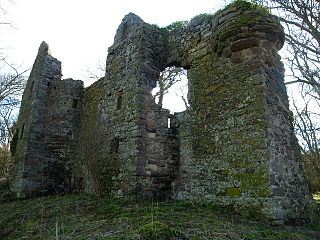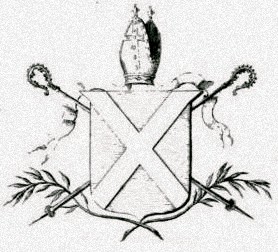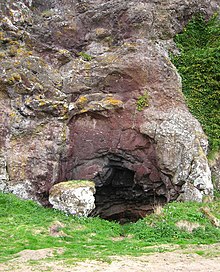
Cuthbert of Lindisfarne was a Catholic Anglo-Saxon saint of the early Northumbrian church in the Celtic tradition. He was a monk, bishop and hermit, associated with the monasteries of Melrose and Lindisfarne in the Kingdom of Northumbria, today in north eastern England and South Eastern Scotland. Both during his life and after his death he became a popular medieval saint of Northern England, with a cult centred on his tomb at Durham Cathedral. Cuthbert is regarded as the patron saint of Northumbria. His feast days are 20 March and 4 September.

East Lothian is one of the 32 council areas of Scotland, as well as a historic county, registration county and lieutenancy area. The county was also known as Haddingtonshire.

The River Tyne is a river in Scotland. It rises in the Moorfoot Hills in Midlothian near Tynehead to the south of Edinburgh, at the junction of the B6458 and the B6367. It continues approximately 30 miles northeast, and empties into the North Sea near Belhaven.
Olaf Guthfrithson or Anlaf Guthfrithson was a Hiberno-Scandinavian (Irish-Viking) leader who ruled Dublin and Viking Northumbria in the 10th century. He was the son of Gofraid ua Ímair and great-grandson of Ímar, making him one of the Uí Ímair. Olaf succeeded his father as King of Dublin in 934 and succeeded in establishing dominance over the Vikings of Limerick when he captured their king, Amlaíb Cenncairech, in 937. That same year he allied with Constantine II of Scotland in an attempt to reclaim the Kingdom of Northumbria which his father had ruled briefly in 927. The forces of Olaf and Constantine were defeated by the English led by Æthelstan at the Battle of Brunanburh in 937.

Dunbar is a town on the North Sea coast in East Lothian in the south-east of Scotland, approximately 30 miles east of Edinburgh and 30 mi (50 km) from the English border north of Berwick-upon-Tweed.

East Linton is a village and former police burgh in East Lothian, Scotland, situated on the River Tyne and A199 road five miles east of Haddington, with an estimated population of 1,790 in 2020. During the 19th century the population increased from 715 inhabitants in 1831 to 1,042 by 1881. The 1961 census showed the village had a population of 1,579. The number dropped significantly at the end of the 20th century, but has subsequently risen again.
Christianity in Medieval Scotland includes all aspects of Christianity in the modern borders of Scotland in the Middle Ages. Christianity was probably introduced to what is now Lowland Scotland by Roman soldiers stationed in the north of the province of Britannia. After the collapse of Roman authority in the fifth century, Christianity is presumed to have survived among the British enclaves in the south of what is now Scotland, but retreated as the pagan Anglo-Saxons advanced. Scotland was largely converted by Irish missions associated with figures such as St Columba, from the fifth to the seventh centuries. These missions founded monastic institutions and collegiate churches that served large areas. Scholars have identified a distinctive form of Celtic Christianity, in which abbots were more significant than bishops, attitudes to clerical celibacy were more relaxed and there were significant differences in practice with Roman Christianity, particularly the form of tonsure and the method of calculating Easter, although most of these issues had been resolved by the mid-seventh century. After the reconversion of Scandinavian Scotland in the tenth century, Christianity under papal authority was the dominant religion of the kingdom.

Auldhame and Scoughall are hamlets in East Lothian, Scotland. They are close to the town of North Berwick and the village of Whitekirk, and are approximately 25 miles (40 km) east of Edinburgh.

Osberht was king of Northumbria in the middle of the 9th century. Sources on Northumbrian history in this period are limited. Osberht's descent is not known and the dating of his reign is problematic.
The Archdeaconry of Lothian, located in modern-day Scotland, was a sub-division of the diocese of St Andrews, one of two archdeaconries within the diocese and in essence that part of the diocese which lay south of the Forth. The Lothian archdeaconry was headed by the Archdeacon of Lothian, a subordinate of the Bishop of St Andrews.

Auldhame Castle is a ruined L-plan tower house standing on a ridge above Seacliff beach, about 3 miles east of North Berwick in East Lothian, and less than half a mile from Tantallon Castle. The castle was built in the 16th century, probably by Adam Otterburn of Reidhall, Lord Provost of Edinburgh. It consists of a three-storey main block with a projecting stair-tower. Part of a vaulted basement remains, but the upper floors are mostly gone.
Tyninghame is a small settlement in East Lothian, Scotland, about two miles north-east of East Linton. Together with the nearby settlement of Whitekirk, it gives its name to the parish of Whitekirk and Tyninghame.
Whitekirk is a small settlement in East Lothian, Scotland. Together with the nearby settlement of Tyninghame, it gives its name to the parish of Whitekirk and Tyninghame.
GuthredHardacnutsson was the Christian king of Viking Northumbria from circa 883 until his death.

Prestonkirk Parish Church is a Church of Scotland parish church at East Linton, in the parish of Traprain, East Lothian, Scotland, UK, close to Preston Mill, Smeaton, Phantassie, and the River Tyne.
Billfrith is an obscure Northumbrian saint credited with providing the jewel and metalwork encrusting the former treasure binding of the Lindisfarne Gospels. His name is thought to mean "peace of the two-edge sword".

The Archdiocese of St Andrews was a territorial episcopal jurisdiction of the Catholic Church in early modern and medieval Scotland. It was the largest, most populous and wealthiest diocese of the medieval Scottish Catholic church, with territory in eastern Scotland stretching from Berwickshire and the Anglo-Scottish border to Aberdeenshire.

In modern contexts Northumbria usually refers to the region of England between the Tees and Tweed, including to the historic counties of Northumberland and Durham, but may also be taken to be synonymous with North East England. The area corresponds to the rump lands of the historical Kingdom of Northumbria, which later developed into the late medieval county of Northumberland or Comitatus Northumbriae, whose original southern boundary was the River Tees. A representative provincial flag of Northumbria is registered for the area.
James Wallace (1770–1852) was a minister of the Church of Scotland who served as Moderator of the General Assembly in 1831, the highest position in the Scottish church.












